Candle Filter
A candle filter is a pressure vessel filled with tubular filters called filter candles. A typical filter candle is comprised of a dip pipe to both flow the filtrate and pressurized gas, a perforated core with supporting tie rods, and a filter sock. The dip tube can also be a central tube surrounded by the candle tubes themselves. The filtrate pipe ensures high liquid flow, as well as maximum distribution of the gas during cake discharge. The tie rods create an annular space between the filter sock and the perforated core, which helps to maintain a low pressure drop during operation and promotes efficient/ gentle expansion of the filter sock during cake discharge. The filter sock is installed over the candle, and can be made of various synthetic materials, capable of removing particles smaller than 1 μm. As the cake builds during operation, the candle filter’s removal efficiency increases, enabling removal of particles as small as approximately 0.3 μm. The filter vessel and candles can be made of various materials. For the vessel, materials include lined carbon steel, stainless steel and alloys and similarly for the candles, including plastics such as polypropylene, PVDF, CPVC as well as titanium.
During operation, a feed pump or pressure from the reactor or feed tank forces the slurry into the bottom of the pressure vessel. The solids build up on the outside of the filter sock, while the liquid filtrate flows into the candle, through the registers, and out of the vessel. This process continues until the maximum pressure drop, design cake thickness, minimum flow, or maximum filtration time is reached. The cake is washed to remove impurities and residual mother liquor, and then dried by blowing gas through the cake. Next, low-pressure gas enters the individual candles or central dip tube and gently expands the filter socks. This process breaks apart the dry cake, which detaches from the filter sock and falls into the vessel cone. Candle filters are used for thin-cake (5–20 mm) pressure filtration applications. They are best suited for filter cakes that are vertically stable.
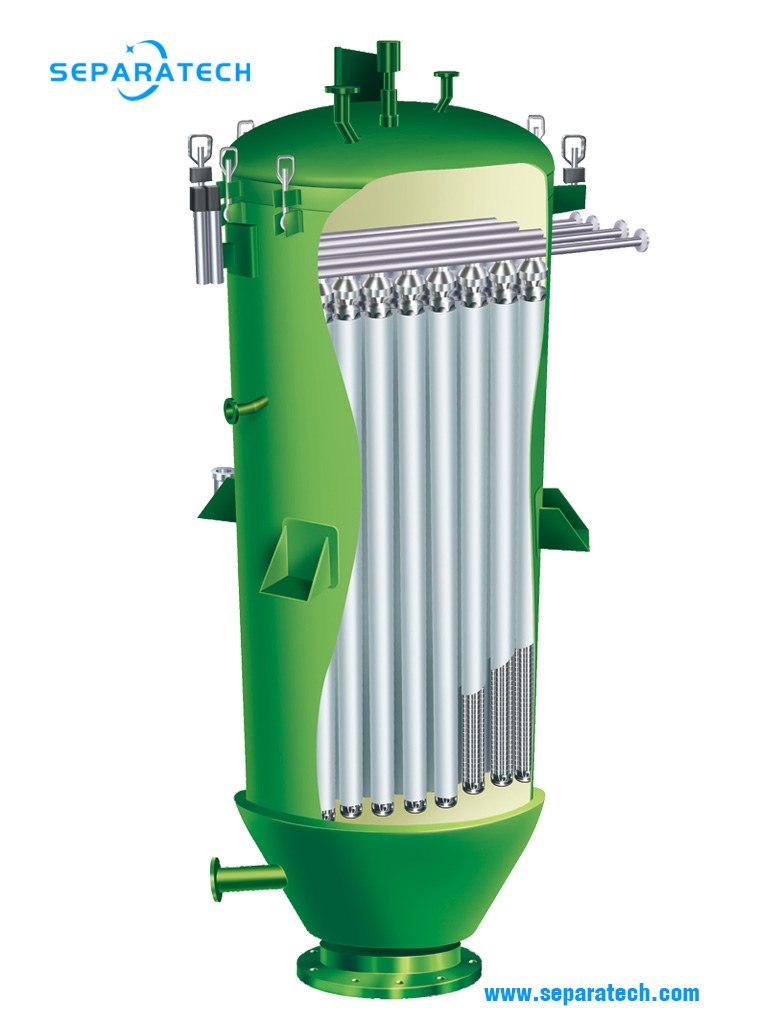
Main structure
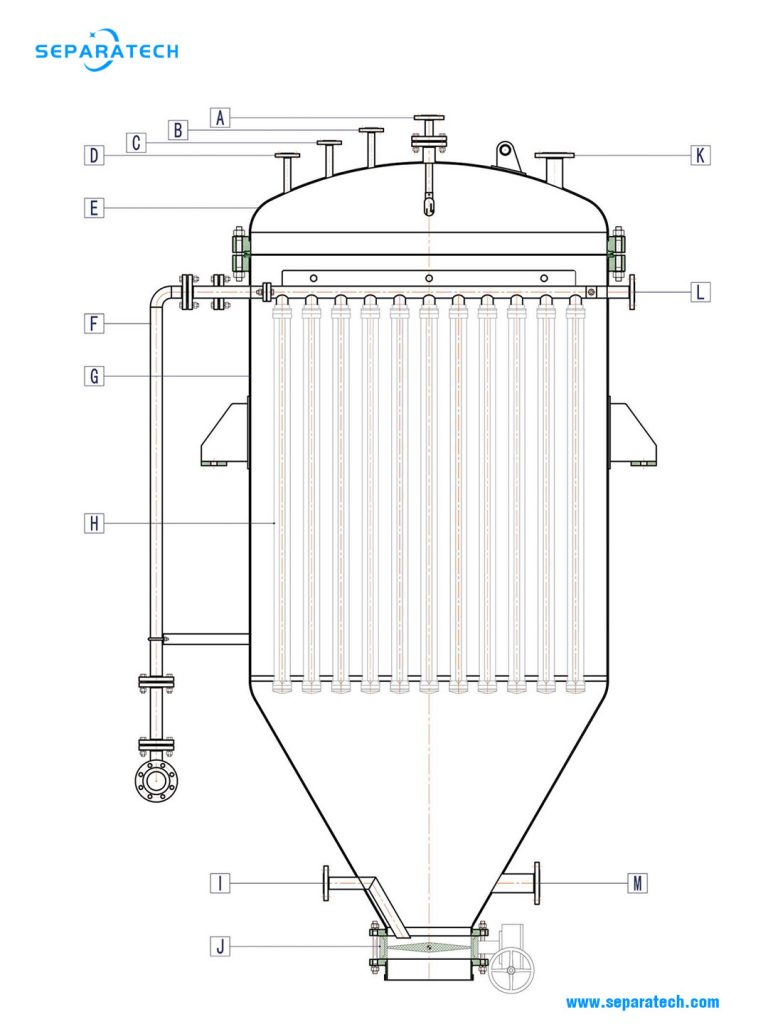
A: CIP port
B: Pressure sensor port
C: Compressed gas inlet
D: Drain port
E: Pressure tank
F: Clear liquid outlet
G: Pressure tank
H: candle filter element
I: Residue drain port
J: Filter cake discharge port
K: Safety valve port
L: Overflow and circulation port
M: Suspension feed port
A candle filter contains multiple mesh candles in the same dimension, which are placed on or screwed on, parallelly. Thus, a large filter area is created for a low construction volume. The candle insert distinguishes itself by a particularly high resistance to differential pressure. Due to the use of stainless-steel wire mesh, the candle filters can be cleaned many times and economically used over a longer period of time. Primarily at high temperatures and in operating conditions in which plastics, fleece or paper are unsuitable, a candle element made from stainless steel is first choice.
Candle filter vessel
The feed to the filter is always positioned at the lower portion of the vessel to allow upflow of the incoming slurry. This is imperative for maintaining fast settling solids in a homogeneous suspension and thus ensure that uniform cakes are formed. An uneven cake thickness that tapers up interferes with the efficiency of cake washing and reduces the effective volume of the cake that accumulates on the filtering elements. To control the upflow velocity an overflow connection is positioned on the dished top and the selected pump must be sized to deliver a higher rate than required for the calculated material balance.
The filtrate outlet from each row of candles is connected to a horizontal header and all headers deliver the filtrate through valves to a collecting manifold for further processing. The arrangement of headers enables individual control on the flow in each row of candles so that increasing flowrate per element during cake formation, sequential cake discharge or backwashing may be used for flexibility of operation. Likewise, incorporating a sight glass on each header enables the monitoring of the quality of the filtrate so that torn cloths may be identified and the entire row isolated. The headers are spaced with special inserts so that the distance between the candles may be modified to accommodate cakes up to 50 mm thickness.
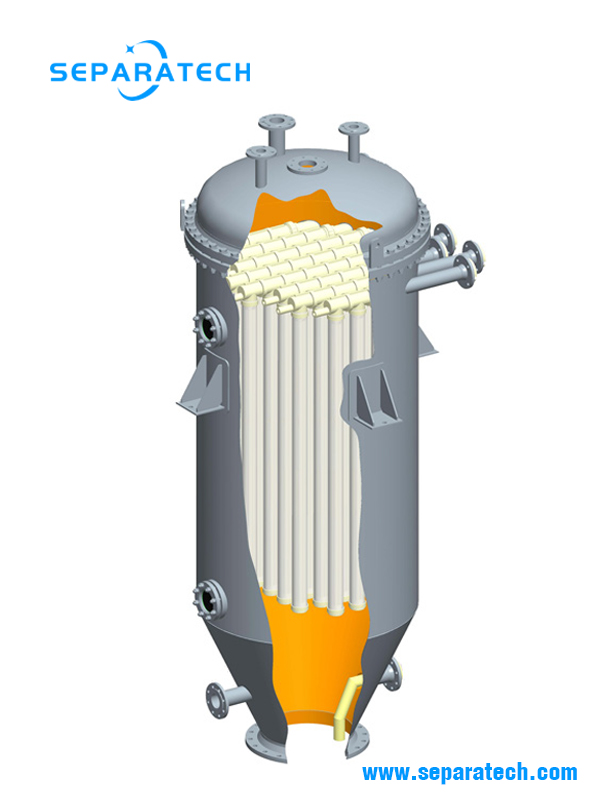
Candle filter element
Filter candles consist of three components: single-piece dip pipe for filtrates and gas, perforated core with outer support tie rods, and filter sock.
The candle filter element serves for filtrate passage and to support the filter medium. The candle filter element may be a bundle of perforated tubes or ball shaped packing material that is contained in a coarse mesh screen sleeve. In the majority of applications the process requires to empty the elements from filtrate at the end of the filtration or washing cycle. This is achieved by inserting a pipe in the middle of the core to fully displace the filtrate during air or gas purging from the bottom of the element and upwards towards the header.
The selection of a suitable filter medium is perhaps one of the main problems confronting the process engineer and requires experience or a systematic trial and error program.
The available types of filter medium are very diverse such as porous ceramics, sintered metal tubes, expanded sheets, woven mesh screens or synthetic filter cloths in sophisticated materials and weaves, mono and multifilament yarns, micron sizes and air permeabilities.
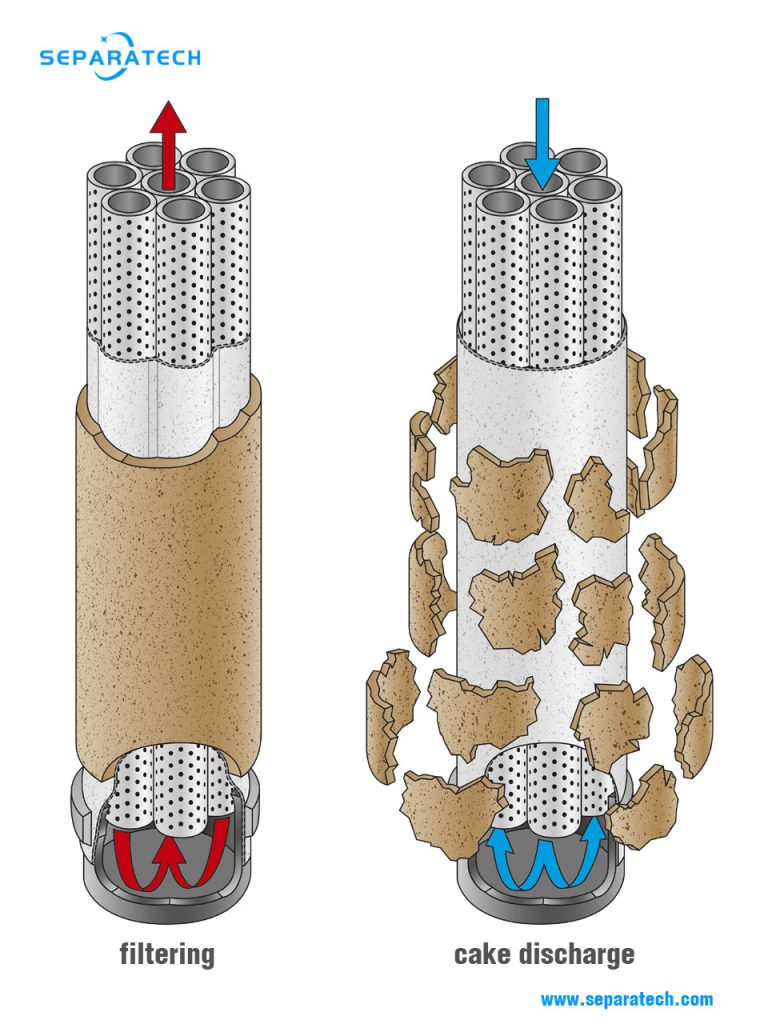
CONTACT OUR FILTER EXPERTS
SEPARATECH is your trusted partner for total engineered filtration solutions. We offer end-to-end solutions from Filter Media to Industry-Leading Filtration Equipment, to Spare Parts & Accessories, to On-Site Field Services and In-House Laboratory Services. Whether for your Filter Press, Belt Press, Leaf Filter, or Vacuum Filter, you can count on SEPARATECH’s deep industry and applications knowledge for the right engineered filtration solution to meet your needs. We look forward to working with your team.
Working principle of candle filter
A candle filter is a type of pressure filter that uses cylindrical elements, called candles, to filter liquids or gases. The working principle of a candle filter is based on the difference in pressure between the inside and the outside of the candles. The liquid or gas to be filtered enters the filter vessel and passes through the candles from outside to inside. The candles are covered with a porous filter medium, such as cloth or metal mesh, that traps the solid particles and allows the clean liquid or gas to exit through the hollow core of the candles. The filtered liquid or gas is then collected and discharged from the filter vessel. The candle filter can operate in batch or continuous mode, depending on the design and application. In batch mode, the filter is cleaned periodically by removing the filter medium and replacing it with a new one, or by backwashing the candles with compressed air or liquid. In continuous mode, the filter is cleaned automatically by rotating or vibrating the candles, which causes the solid particles to fall off and be collected at the bottom of the filter vessel.
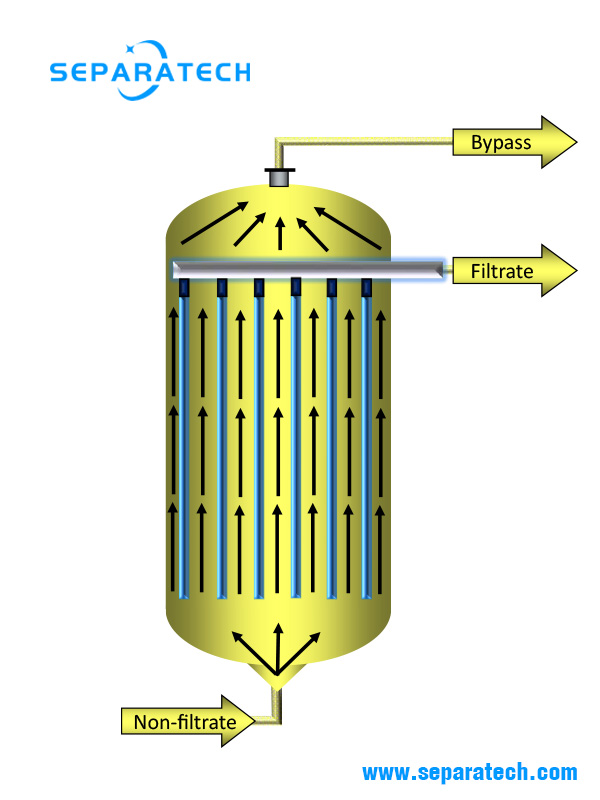
Operational Sequence of candle filter
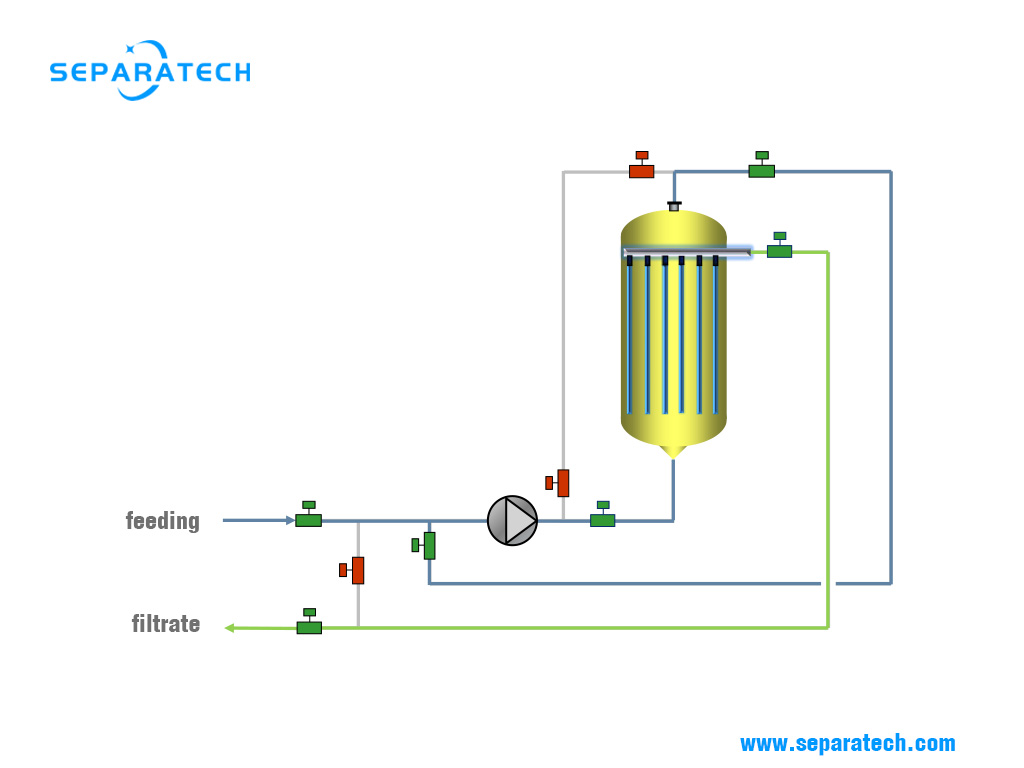
In its simplest set up, a Candle Filter can operate in three stages: Filling, Filtration, and Discharge. Depending on the process, the operation can include all or most of these steps listed below:
Precoating- If your solid is the product, then precoat is likely not for your operation since it mixes filter aid into the cake. If your slurry is sticky or if you need very clear filtrate right at start-up then running diatomaceous earth, perlite, or another filter aid prior to filtration may be a step you should take.
Filling- Slurry enters the vessel from the bottom, compressing the air or gas in the vessel above the candles and headers.
Filtration– Increasing pressure forces filtrate through the filter media on the candles, through the headers, and out the filtrate outlet. Solids are collected on the filter media and form a cake.
Washing- Spray bars near the headers can clean cake down the length of the candles.
Drying- Steam or gas replaces slurry and is forced through the cake and candles until there is no more filtrate to capture
Heel Removal- Air or gas fills the vessel and presses the remaining slurry out a pipe on the bottom and back into the feed tank.
Discharge- Both the slurry inlet and the filtrate outlet are closed. The sludge drain on the bottom of the vessel opens. The condensed air or gas trapped in a bubble above the candles and headers gets forced out the sludge drain. This backwash breaks the cake off the candles and it is discharged. The unit is now ready to begin filling again.
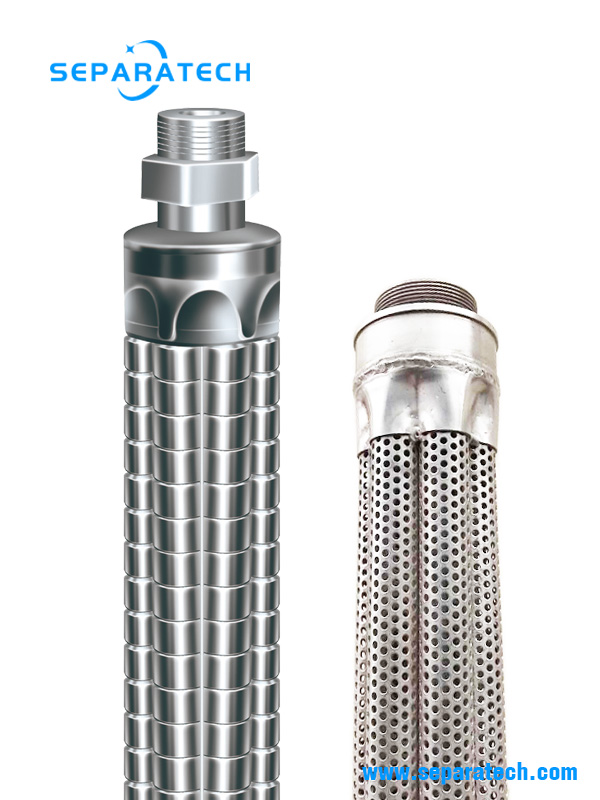
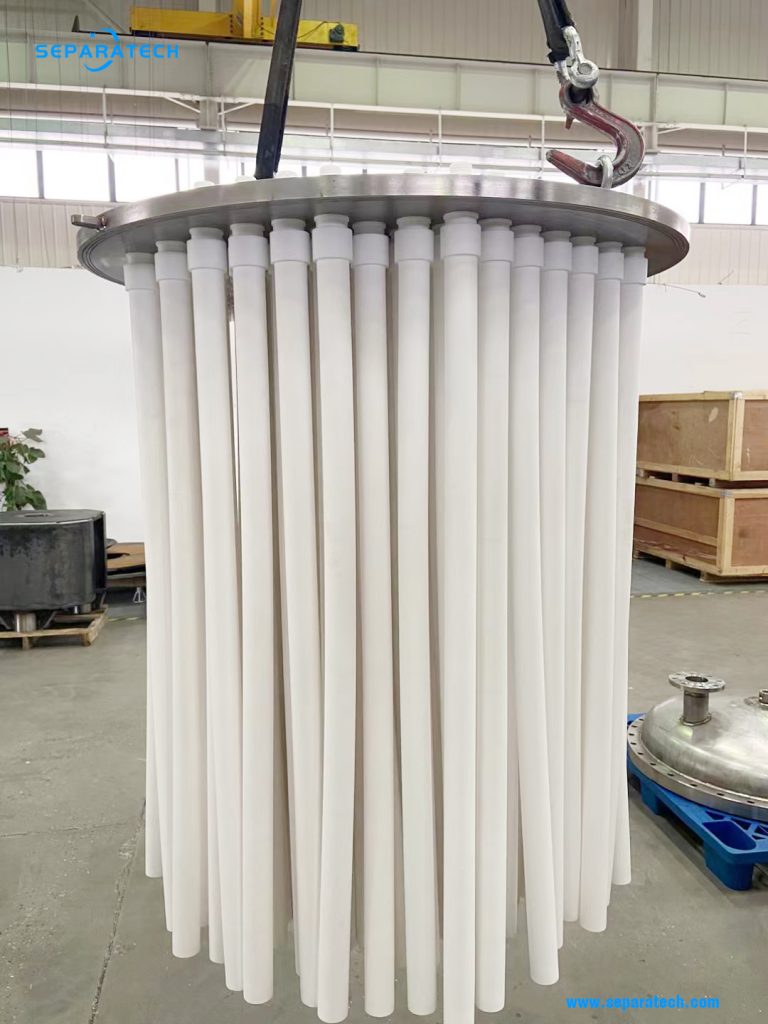
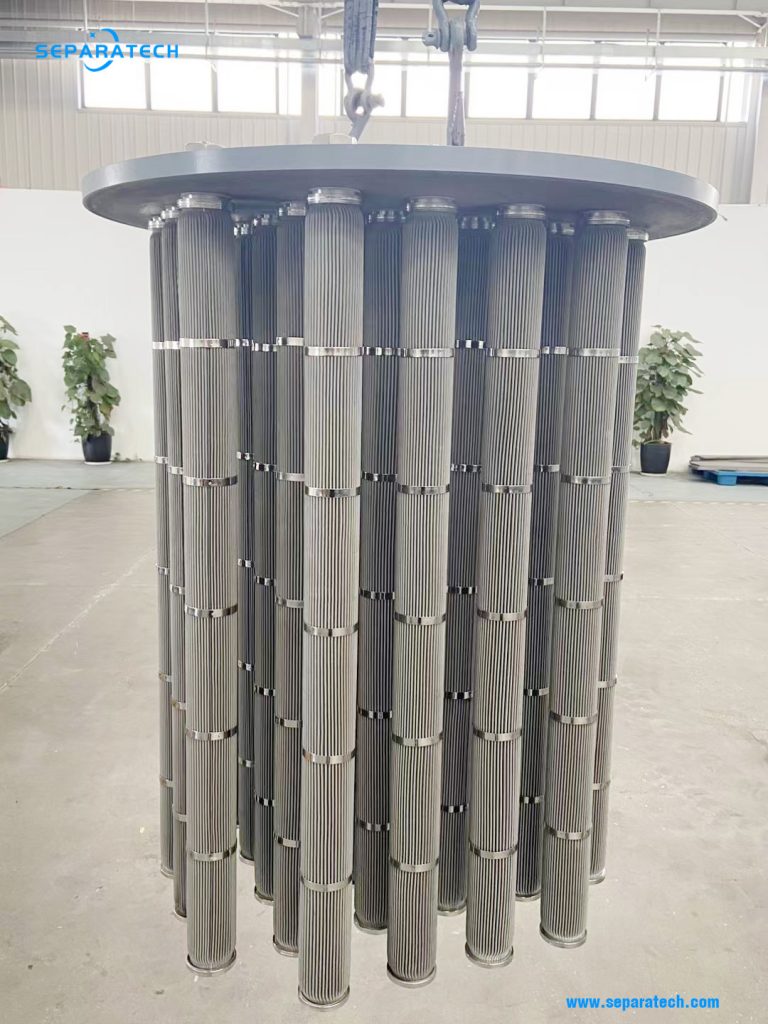
Benefits
– Significantly larger filter area and longer service life
– Fewer components are required and cleaning is easier
– Candle filters can be replaced individually
– Excellent cake discharge
– Adapts readily to slurry thickening
– Minimum floor space
– Mechanically simple since there are no complex sealing glands or bearings
For cleaning, they are easily removed from the closed-off filter chamber, manually cleaned using a liquid cleaning fluid, blown out using compressed air and inserted into the filter. Due to attachment and locating the filter element, conditional to the shape, the greatest process reliability is ensured.
Candle filter applications
Candle filters are industrial filters that are used for various applications, such as filtration, polishing, and thickening of liquids, slurries, or solids. They have a large filter surface and a high differential pressure resistance, which makes them suitable for substances that require low moisture content and a high degree of clarity. Some of the common applications of candle filters are:
– Pharmaceutical filters: Candle filters can remove impurities and contaminants from drugs and other pharmaceutical products.
– Fine chemistry filters: Candle filters can separate fine particles and catalysts from chemical reactions and processes.
– Food industry filters: Candle filters can meet the FDA standards for filtering food products, such as oils, syrups, juices, etc.
– Fuel and oil additive filters: Candle filters can purify fuels and oils from additives and other substances that may affect their quality and performance.
– Hazardous materials filters: Candle filters can handle toxic and corrosive substances safely and efficiently, such as titanium oxide, flue gas, brine, etc.
– Precious metal and catalyst recovery filters: Candle filters can recover valuable materials from liquids or slurries, such as gold, silver, platinum, palladium, etc.
Technical data
| Desiganation | Filtering Area (m2) | lnside Diameter (mm) | Effective Volume (m3) | Cake Capacity (L) | Weight (Kg) | Total Height (mm) |
|---|---|---|---|---|---|---|
| CFX1 | 0.15 | 168 | 0.01 | 1.5 | 35 | 1200 |
| CFX3 | 0.45 | 325 | 0.04 | 5 | 50 | 1350 |
| CFX6 | 1.25 | 500 | 0.25 | 15 | 200 | 1800 |
| CFX10 | 2.15 | 600 | 0.35 | 25 | 300 | 1850 |
| CFX16 | 4.5 | 800 | 0.75 | 45 | 450 | 2500 |
| CFX24 | 8.5 | 1000 | 1.5 | 100 | 600 | 2750 |
| CFX36 | 15 | 1200 | 2.5 | 200 | 800 | 3150 |
| CFX48 | 20 | 1400 | 3.25 | 300 | 1250 | 3250 |
| CFX69 | 30 | 1600 | 4.5 | 450 | 2000 | 3500 |
| CFX88 | 40 | 1800 | 6 | 600 | 3000 | 3750 |